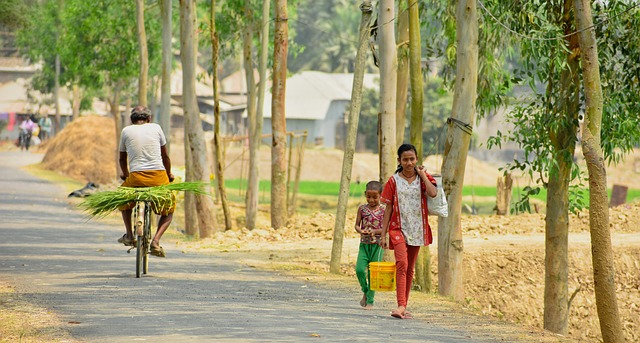Class IX Economics The Story of Village Palampur Lesson Plan
Class IX Economics Lesson Plan is of one of the foundational chapters “The Story of Palampur.” This chapter takes students on a journey to a small village called Palampur, exploring its economic activities and understanding the factors that contribute to its sustenance. This class IX Economics lesson plan will serve as a microcosm of the broader economic concepts, introducing students to key terms such as production, factors of production, and different forms of farming. Through the story of Palampur, students learn about the significance of land, labor, capital, and entrepreneurship in the production process. They gain insights into the challenges faced by farmers and explore the interplay between the rural and urban sectors of the economy. This class IX Economics lesson plan aims to engage students in a comprehensive study of Palampur’s economy, fostering a deeper understanding of the fundamental principles of economics.
The French Revolution Lesson Plan For Class IX : As Per CBSE Guidelines
Class IX Economics Lesson Plan: Chapter 1 The Story of Palampur
Learning Objective:
- Understand the basic concepts of production and factors of production.
- Comprehend the economic activities in a village like Palampur.
- Analyze the importance of multiple sources of income and the role of laborers.
Teaching Points:
- Introduction to the village of Palampur:
- Location, population, and basic amenities.
- A brief overview of the agricultural and non-agricultural activities.
- Factors of Production:
- Definition and explanation of land, labor, capital, and entrepreneurship.
- Discussion on their importance in the production process.
- Farming in Palampur:
- Explanation of the multiple cropping and modern farming methods.
- Role of irrigation, fertilizers, and machinery in agricultural production.
- Illustration of the challenges faced by farmers (lack of modern technology, inadequate credit, etc.).
- Non-agricultural Activities:
- Description of small-scale manufacturing, dairy, and other activities.
- Understanding the significance of these activities in generating employment.
Teaching Aids:
- Whiteboard and markers.
- Visual aids (images, charts, or diagrams) representing the village of Palampur, factors of production, and various economic activities.
- Worksheets or handouts for students.
Methodology:
Firstly, the teacher begin the class by asking students about their understanding of production and the factors involved.
Secondly, he / She Introduces the village of Palampur using visual aids and encourage students to discuss its features.
Thirdly, explains the concept of factors of production through examples and engage students in a brief discussion.
Fourthly, present information about farming in Palampur, utilizing visual aids to enhance understanding.
Further, discuss non-agricultural activities, highlighting their importance and impact on the village economy.
Finally, encourage students to ask questions and participate actively in the discussion.
Class Work:
The teacher divides the students into small groups.
Assign each group a specific economic activity (farming, dairy, manufacturing, etc.).
Ask each group to research and prepare a short presentation on their assigned activity.
Allocate time for each group to present their findings to the class, followed by a class discussion.
Home Work:
- Assign students to write a short essay on the role of factors of production in the village of Palampur.
- Ask students to create a diagram or flowchart illustrating the different economic activities in Palampur.
Activity 1:
The teacher conducts a group activity where students simulate a marketplace in Palampur.
To conduct a group activity where students simulate a marketplace in Palampur, the teacher will follow these steps:
Introduction:
The teacher begin by introducing the concept of a marketplace.
Explains its significance in the context of Palampur, which is a village in India known for its agricultural activities.
Research and Discussion:
Encourage students to research and gather information about the typical goods and services available in Palampur’s marketplace.
Discuss the various aspects such as agriculture, handicrafts, dairy products, and other local produce that can be simulated in the activity.
Role Assignment:
Further, divide the students into groups and assign each group a specific role to play in the marketplace simulation.
Roles can include farmers, artisans, traders, consumers, and government officials responsible for managing the marketplace.
Planning:
Each group should brainstorm and plan the products or services they will offer in the marketplace simulation.
They should consider factors such as pricing, production, availability, and marketing strategies.
Resource Allocation:
Discuss with the students the availability of resources (imitation money, tables, display boards, etc.) that can be used to create a realistic marketplace
setting.
Allocate these resources to the groups accordingly.
Setting Up the Marketplace:
In the classroom or designated area, allow each group to set up their stalls or stations to represent the different aspects of Palampur’s marketplace.
Encourage them to create appealing displays and decorations.
Simulation:
Give the students time to simulate the marketplace.
They should interact with each other as buyers and sellers, negotiate prices, exchange goods, and engage in trade.
Encourage them to use the information they gathered during their research to make the simulation more realistic.
Observation and Participation:
As the teacher, observe the students’ activities and provide guidance and support when needed.
Participate in the simulation as a customer or a government official, interacting with the students to enhance their experience.
Reflection and Discussion:
After the simulation, gather the students for a debriefing session.
Encourage them to share their experiences, challenges faced, and lessons learned during the activity.
Discuss the importance of markets and the role they play in the economy.
Follow-up Activities:
Depending on the time available,
assign follow-up activities such as writing reflections, creating posters, or conducting further research on the economic aspects of Palampur.
By conducting this group activity,
students will not only gain a better understanding of how a marketplace operates but also develop teamwork, negotiation, and communication skills.
Activity 2
Role play: Assign roles such as farmers, laborers, shopkeepers, etc., and simulate the exchange of goods and services.
To conduct a role-play activity where students simulate the exchange of goods and services with assigned roles such as farmers, laborers, shopkeepers,
etc., a teacher can follow these steps:
Introduction:
Start by introducing the concept of role-play and its purpose in understanding the exchange of goods and services in a simulated scenario.
Explain that each student will be assigned a specific role to play.
Research and Preparation:
Provide students with information about the roles they will be assigned, such as the responsibilities, tasks, and characteristics of each role.
Encourage them to research and gather relevant information to understand their role better.
Role Assignment:
Assign each student a role based on their interests or randomly distribute the roles among the students.
Roles can include farmers, laborers, shopkeepers, consumers, government officials, and any other relevant roles in the context you are focusing on.
Scenario Development:
Develop a scenario or a setting where the exchange of goods and services will take place.
For example, it could be a rural village, an urban marketplace, or a specific historical period.
Provide some background information to help students understand the context of the simulation.
Planning:
Give students time to plan their roles and discuss with their peers who have similar roles.
They can discuss strategies, pricing, and other relevant aspects to make the simulation more realistic.
Setting Up:
Allocate space in the classroom or designated area for students to set up their role play stations.
Each group or individual should create an environment that reflects their assigned role.
For example, farmers can have produce displays, shopkeepers can arrange their products, and laborers can have tools and equipment.
Exchange of Goods and Services:
Start the role-play activity and allow students to interact and engage in the exchange of goods and services.
Encourage them to stay in character and negotiate prices, quantities, and other aspects of the exchange.
Observation and Participation:
As the teacher, observe the role-play activity, paying attention to how students perform their roles and interact with each other.
Participate in the activity by taking on a relevant role, such as a customer or a government official, to enhance the experience and guide students when
needed.
Reflection and Discussion:
After the role-play activity, gather the students for a debriefing session.
Ask them to reflect on their experiences and share their insights.
Discuss the challenges they faced, the strategies they employed, and the lessons they learned about the exchange of goods and services.
Extension Activities:
To further enhance learning, assign follow-up activities.
Such as writing reflections or essays about the role-play experience.
Conducting research on the economic aspects of the roles, or discussing real-life examples of the exchange of goods and services.
By conducting this role-play activity, students will not only gain a practical understanding of the exchange of goods and services,
but also develop empathy, communication skills, and problem-solving abilities in a simulated real-world context.
Remedial Measures:
- Provide additional explanations and examples to students who are struggling with understanding the concepts.
- Offer one-on-one assistance during class or after school for students who need extra support.
- Encourage peer learning and collaboration among students.
Learning Outcome:
By the end of this lesson, students should be able to:
- Identify and explain the factors of production.
- Understand the different economic activities in the village of Palampur.
- Analyze the importance of multiple sources of income and the role of laborers.
Conclusion:
In this class IX Economics lesson plan lesson, we explored the story of Palampur and its economic activities. We discussed the factors of production, farming techniques, and non-agricultural activities. This class IX Economics lesson plan also has group activities and assignments to reinforce the concepts learned. Understanding the economics of Palampur will help students grasp the broader concepts of production, income generation, and the importance of various economic activities in a village economy. Hope, you will find this class IX Economics lesson plan useful, practical & interesting. For class IX History lesson Plan and Geography lesson plan click on the given link.
11 Points You Must Include In Your Disaster Management Project On Climate Change
How To Write a Project On Globalization And Its Impact On Economic Development Worldwide





0 Comments